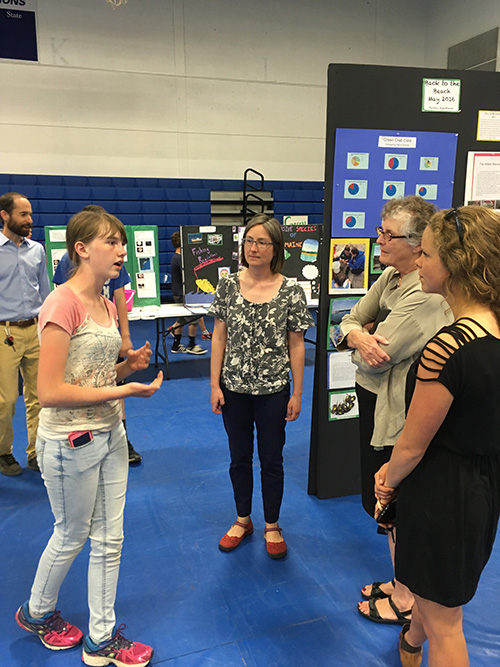
A Bath Middle School student explains the project to (from right: Bath Middle School teacher Monica Wright, NRCM board member Kathy Remmel, and NRCM Grant Program Intern Britta Clark.
Summer is almost here, and NRCM “Engaging Maine Middle School Students in Protecting the Nature of Maine” Grant Awardees are presenting their final projects to NRCM members and staff. Check out this update from NRCM Communications Intern Britta Clark, who visited Bath Middle School and learned about their work with green crabs in Maine:
This past Wednesday, NRCM’s Kathy Remmel, Gabrielle Grunkemeyer, and I headed to Bath Middle School to see their Celebration of Learning, including a presentation about the Green Crab study they have been working on this semester.
What a fantastic project! With funding from NRCM, Bath Middle, headed by teacher Monica Wright, was able to purchase a few green crab traps and travel to Popham and Reid state parks to collect data on numbers of crabs, and record the sex, width, and color. When students measured in the fall, they noticed a marked difference between the proportion of male and female crabs at the different testing sites—most of the crabs at Popham were female whereas most of the crabs at Reid were male. This spring, they have been amassing further data and proposing hypotheses as to why this may be.
I was incredibly impressed with Bath Middle School’s work, most especially the way in which students have become real scientists. I remember being frustrated in Middle and High School with experiments in which it was clear before we even began what the answer would be—the experiments felt pointless. This was absolutely not the case with Bath Middle School. The data they collected was from the real world, meaning it was messy, complicated, and sometimes hard to explain. While this can be frustrating, Bath Middle School students and teachers embraced the challenge, creating a huge number of interesting and important graphs to display their findings, and additionally submitting their data to a citizen science website. Even more importantly, Bath Middle School is planning on continuing this work by continuing to collect data in upcoming years. To me, this kind of long-term investment was awesome to see; students who explained their work to me clearly felt like they were a part of something real and lasting. When I heard from a group of girls about Dasysiphonia, an invasive plant species that Bath also collected data on, I asked if anyone had come up with any good ways of removing or killing the plant. The girls responded that there were no solutions yet, but they would work on it! It is clear that when students are immersed in authentic projects and problems, they become incredibly engaged and interested.
Thanks to Bath Middle School students and teachers for such amazing work—we look forward to hearing about your future findings!










Leave a Reply